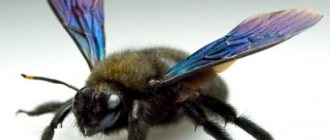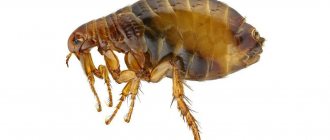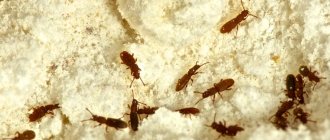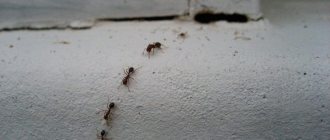Wild bees that build nests in the ground, called earth bees, usually live far from populated areas, in forests. Violation of the ecological situation led to a reduction in the population of stinging insects and changed their behavior - they began to prefer low-rise buildings and summer cottages. Is such a neighborhood dangerous?
Bees' home
Ground bees, true to their name, live in the ground. They themselves are not very willing to dig holes for themselves; they often use those free from rodents. They live in a swarm and build a home for themselves, only inside. One queen begins:
- Finds a suitable place.
- They build a hole and make a series of rooms.
- Leaves are placed on the bottom.
- Lay the first layer of eggs.
- They take care of the nutrition of the first generation.
- Nectar is placed in special chambers.
Dig ↑
Let's look at the advantages and disadvantages.
- Different types of burrows are constructed differently. It’s worth trying to find out who is staying with you? If you are a fan of shallow holes in the ground, you are in luck. A shovel in your hands - and the whole struggle will end quickly. If not, do some serious excavation work in your own garden planted with vegetables... it’s worth thinking about other methods.
- The existing bees do not welcome your efforts. There is a possibility of being stung. To reduce it, protect yourself: wear suitable clothing. A spacesuit is not necessary; a jacket with a hood also helps. And if you are allergic to bites, be sure to take appropriate medications with you. And go in company – it’s better for your health. You never know...
- You can also spot inconspicuous burrows in passing. Some types of mink, with ready-made bread and laid eggs, are closed with an earthen plug. Such a camouflaged hole may not be noticed. Since solitary bees often settle in a colony, the burrows are nearby, there is a chance of discovering it by accident while digging. And get rid of the bees that have not yet grown.
- Bee food is quite edible for humans. There won’t be a lot of it, but there will be enough “to try.” It’s understandable if you don’t mind eating something unusual, not wrapped in cellophane and with the missing “non-GMO” sign. And so as not to be considered robbery, let’s call them “battle trophies.”
Honey production
Bees living in the ground remain bees. They live for one season, but store honey. There are a lot of people who want to get it, wild honey. The production process goes like this:
- Bees collect nectar;
- transferred and fermented;
- placed in wax honeycombs;
- sealed.
Lovers of wild honey from earth bees try in every possible way to get it - they steal their tunnels, for which they immediately become brutally bitten.
Character of bees
Ground bees are not harmful at all and have a calm character. But they can sting when it is necessary to protect offspring or their own territory. Their bite will not cause more trouble than the bite of other types of bees. Torment is caused only by manifestations of allergies in those people who are prone to it.
If you are bitten by a ground wasp, you need to:
- Remove the sting by carefully prying it up with tweezers or your fingernails.
- Disinfect the bite site with alcohol, brilliant green or peroxide.
- Treat with antihistamine cream.
Ground bee.
When to worry:
- if you have a tendency to allergies;
- if the bites were numerous;
- when the place was on the lips, larynx or tongue.
Environment and habitat features
Wild bees live in colonies in a hive hidden from us, consisting of hundreds of passages. The walls of the “corridors” are strengthened by mixing soil with saliva. Females collect nectar to create a nutritional cushion for future offspring. After 14 days of laying the eggs, the “children” contribute to the construction of the underground hive. There are species that live in small families, as well as solitary ones.
The habitat of ground wasps is soil or its surface, quiet corners with a good food supply. Often for the wasp family, living on the ground is a forced temporary measure caused by unfavorable conditions. Offspring can easily change their place of residence to a hollow tree or a crack in the wall.
Common types of ground bees
Many species are representatives of the Red Book. They encountered people so often that they are now endangered. But there are some species that still occur periodically.
Andrena Clarkella
Andrena Clarkella.
A bee with a lot of fur, which makes it look like a bumblebee. The hind legs of this species are distinctively beautiful and prominent - they are densely covered with red hair.
They have a clear difference between the sexes: females are larger, rounder, and have a sting. Males, on the contrary, are thinner and have long antennae.
Leaf cutter
Leaf cutter bee.
A representative of solitary creatures that finds a place for a nest in the trees. It is very easy to notice their effect - they cut the leaves evenly or in a rounded shape.
These bees have a short lifespan - 2 months for the female and a month for the male. The parents mate, prepare the place, lay eggs and prepare shoots, and then die.
Woolbeaters
Little bees that love to live under the bark in trunks. These are frequent guests of botanical gardens and public gardens. They use wood to make cozy nurseries for children. They look very nice.
Woolbeaters.
Interesting facts
- Despite the name of earthen insects suggesting the construction of dwellings under the crust of the soil, sometimes these hymenoptera insects build houses not in the soil, but in crevices of some origin, for example, in the crevices of the walls of abandoned houses, between the masonry of ancient structures.
- Matriarchy reigns in the families of earth bees - it is the queen who is the head of the family. She plays a decisive role in choosing a place for the formation of a new home. All members of the bee family obey and protect her. In addition, the central role of the queen bee is also evidenced by the fact of polyandry present in the life of insects.
- To create future offspring, a striped female needs a little time - from one to two weeks. When the offspring grows up, the female dies.
- Ground bees, despite their huge role in agriculture, are still wild and not domesticated.
You can watch the video about the life of wild bees living under the ground cover:
Neighborhood with earth bees
You need to start methods of dealing with earth bees with one question - is it worth expelling them? They do not live in large colonies and usually do not cause trouble.
Benefits of Ground Bees
Ground bee.
They pollinate flowers and trees well. Small animals store a lot of food for their offspring, and since their life span is short, they do this intensively and very actively.
Ground bees love alfalfa, which ordinary bees do not like. Colonies, especially leaf cutters, cope with this task very well and are even lured specifically for this purpose.
Characteristics of honey
Most earth bees, like domestic bees, produce tasty and healthy honey. The product has a thick consistency, tart taste and smoky aroma. Honey contains a large amount of beebread and wax, so the product is somewhat darker than the usual honey from the apiary. According to experts, this honey is useful for:
- acute respiratory infections;
- digestive problems;
- in inflammatory processes.
In terms of chemical composition, honey from earthen bees differs slightly from homemade honey and is an excellent immunomodulatory agent. However, the collection of such a product is always associated with the destruction of the bee colony, which many environmentalists do not approve of.
It is practically impossible to find such a product on store shelves - it is difficult to obtain, and also not always ethical.
How to deal with earth bees
If you decide to start fighting bees, then you need to determine the method and prepare yourself. All measures must be taken taking into account safety requirements.
There are several basic ways to control insects.
Water
Boiling water works best and most effectively. Depending on the size of the nest, several buckets of water will be needed. They are quickly poured out and the entrance is closed with a stone. Repeat if necessary.
Fire
Any flammable liquid can be used. It is poured into a hole that the bees use as a nest and set on fire. This method should not be used near a barn or buildings. Beware of angry bees.
Poison
Special preparations that serve as poison will help get rid of earth bees. There are many of them on sale, produced in various forms. They spray the nest with them and close the entrance so that they do not fly out.
If necessary, a number of procedures must be repeated. After the nest is destroyed, the place is dug up.
Try to solve the problem peacefully
The first option on how to get rid of annoying neighbor bees is to negotiate with a beekeeper. If he is adequate and thinks sensibly, then he will agree to compromise terms. To resolve the conflict, it is recommended to propose a method of resolving the situation:
- The beekeeper replaces the breed of his “pets” with more peaceful individuals. For example, Karnik bees are distinguished by their friendliness, rare display of aggression, and hard work. The beekeeper also benefits from this option.
- Installation of a solid fence with a height of at least 2 meters. This will limit the flight of insects.
- Planting shrubs and trees that grow quickly between your own territory and the hives.
- Relocation of bee houses from nearby residential buildings. The minimum distance is 30 meters. In this situation, insects will be able to live and work peacefully without disturbing others.
- Change of mother. Often the reason for the aggression of working women is the embitterment of the queen bee. If you replace it, the insects will become calmer.
The most favorable option is to agree to move the apiary to another area, away from the populated area. With the right choice of site, you can increase the productivity of beekeeping activities, which will be a pleasant bonus for the beekeeper.
What you need to know about security
Ground bees are dangerous representatives of the species. Although they themselves do not attack on a whim or of their own accord. But in case of danger, they will launch their attack.
When working with bees, you must follow safety precautions:
- Wear a protective suit when working to protect against bees.
Protective suit for working with bees.
- It is better to work in the dark, when insects are less active.
- Chemicals should be diluted and used strictly according to instructions.
- If insects begin to attack, it is better to flee. They attack as a whole group very easily and quickly.
- During work, protect children and pets, even warn neighbors.
The best time for "military" actions
Remove insect nests in spring or late fall when they are empty. Burn any nests you find. In summer there is no point in fighting in the morning and during the day: insects fly away and nests are empty. The vindictive minke whales, not finding a home, will begin to take revenge - actively attack. So it is best to destroy wasp nests in the evening, together with the owners.
If a wasp or bee does sting you, proceed as follows:
- Carefully examine the wound. If you find a sting, be sure to remove it.
- Apply cold to the bite site - the pain will decrease and the swelling will subside.
- Lubricate the affected area (whatever you can):
- ointment with prednisolone;
garlic;
- onions;
- parsley
- Make a lotion:
- with ammonia diluted in water in a ratio of 1:5;
- with soda solution - 1 teaspoon per half glass of water.
- Take an antiallergic drug: suprastin, diazolin, etc.
Or:
This is interesting: How to get rid of bees in the wall of a wooden house - read the essence
How to secure the site
Typically, earth bees do not cause much trouble or harm to people. Their small family usually settles close to a food source and does not interfere with human habitation. But they happen; they are attracted to gardeners without knowing it.
Honey plants are very popular with bees, who prefer to feed on their pollen and nectar. A large number of them will attract Hymenoptera.
Accordingly, it's the other way around. There are those plants that repel insects with their smell. These include:
- lavender;
- calendula;
- basil;
- Melissa;
- sagebrush;
- mint.
Prevention measures
The following recommendations will help you avoid attacks and spread of earth bees.
- When working in the garden, it is better to wear clothing that is as closed as possible.
- There is no need to plant flowers in the garden with a strong fragrant smell that will attract insects.
- Wild insects don't like the smell of lavender. Therefore, it is enough to plant such a plant on your site so that the bees do not take a fancy to it.
Sources:
https://medapaseka.ru/o-pchelah/zemlyanye-pchely-polza-ili-vred.html https://mirpchely.ru/pchelovodstvo/pchely/zemlyanye https://apest.ru/nasekomye/pchely/kak- izbavitsya-ot-zemlyanyh-pchel/











